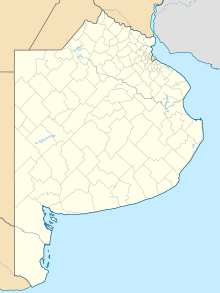Villa Epecuén
Coordinates: 37 ° 8 ′ S , 62 ° 49 ′ W
Villa Epecuén was an Argentine tourist town on Lake Epecuén about 600 km southwest of Buenos Aires in the province of Buenos Aires .
history
Villa Epecuén was officially founded on January 23, 1921. The basis of the economic development of the small town was the nearby Lago Epecuén, a lake whose water had the second highest salinity after the Dead Sea. First, the salt should be extracted and made usable as a product. At the same time, word got around about the therapeutic effects of the water and Villa Epecuén soon flourished as a tourist destination. With health tourism came hotels, restaurants and leisure facilities. The boom was intensified by the Second World War , as the health resorts in Europe could no longer be reached from South America, or only with great danger. At times there were five thousand guests for every two thousand inhabitants and the city was given a direct rail link to Buenos Aires.
Sewer construction
Since the 1930s and 1940s saw very little rainfall, Lago Epecuén was constantly shrinking. In order to be able to maintain bathing operations in Villa Epecuén, the government of the province of Buenos Aires decided to build the 25 km long Ameghino Canal. This collected water from more distant lakes and rivers and channeled it into a system of six large lakes, the last of which was Lago Epecuén. As a result, the salt content in the lake fell, the main reason for the flow of visitors, but that appeared to be the lesser evil compared to the further silting up of the lake. In the 1980s, the amount of precipitation rose sharply again.
Downfall
In 1985, unusually heavy rainfall led to a steady rise in the water level in the lake for weeks, which only had a small, poorly maintained drain. On November 10, 1985, the clay dams at Villa Epecuén broke in several places and the water spilled into the city. Within hours the city sank into the floods and had to be abandoned. Reconstruction seemed impossible and so Villa Epecuén sank into the lake for 25 years.
Villa Epecuén today
Since 2009 the water has been withdrawing again due to the regional lack of rain and releasing the remains of the city. It shows itself devastated, but at the same time as a snapshot of the day of its downfall. Roads, wrecked vehicles, furniture, toys and billboards have been preserved in a salt-encrusted layer and are an unreal sight. Remnants of trees seem to be standing on their exposed roots and the ruins of the former slaughterhouse on the outskirts are a popular photo opportunity.
Web links
Individual evidence
- ↑ a b Argentina's Atlantis , spiegel.de
- ↑ Argentina's Atlantis rises again from the water , Die Welt



